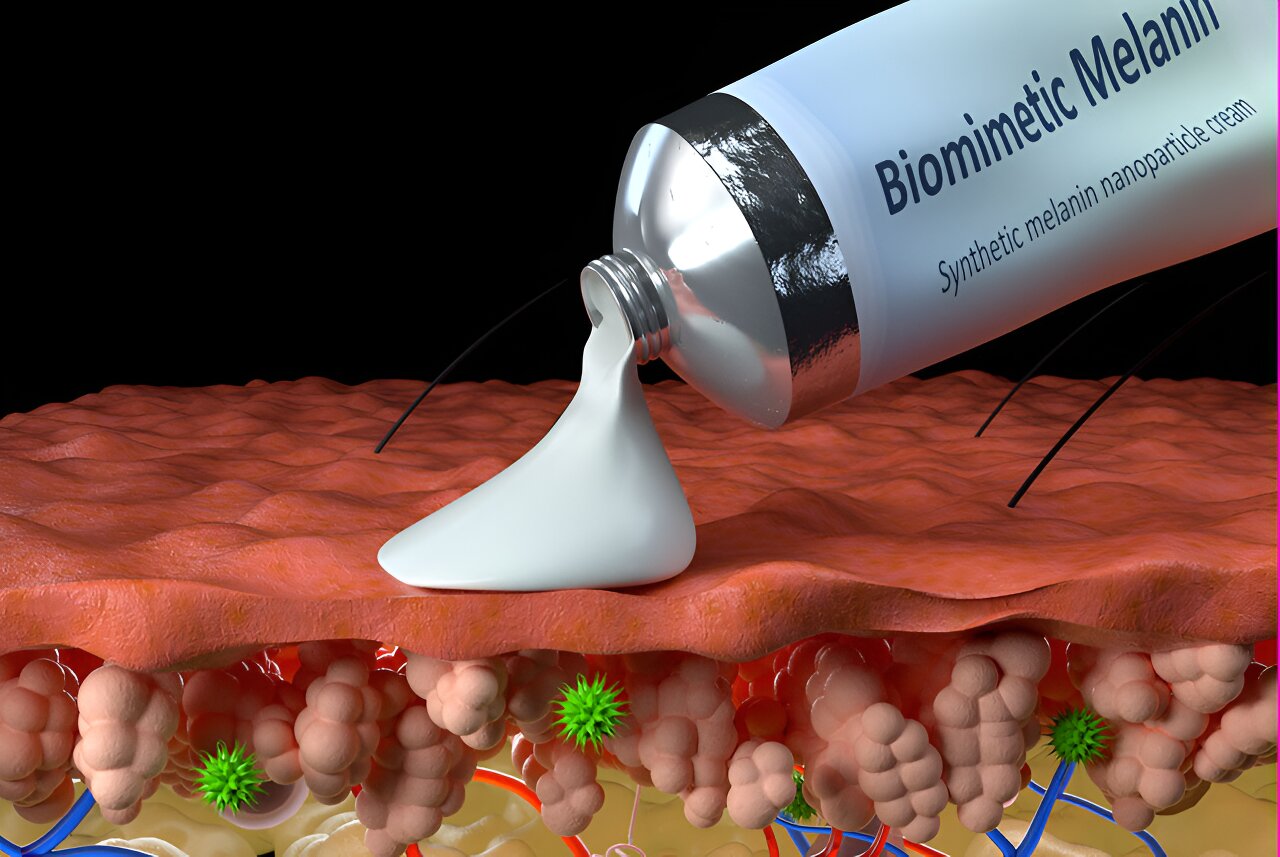
Imagine a skin cream that heals damage occurring throughout the day when your skin is exposed to sunlight or environmental toxins. That’s the potential of a synthetic, biomimetic melanin developed by scientists at Northwestern University.
In a new study, the scientists show that their synthetic melanin, mimicking the natural melanin in human skin, can be applied topically to injured skin, where it accelerates wound healing. These effects occur both in the skin itself and systemically in the body.
When applied in a cream, the synthetic melanin can protect skin from sun exposure and heals skin injured by sun damage or chemical burns, the scientists said. The technology works by scavenging free radicals, which are produced by injured skin such as a sunburn. Left unchecked, free radical activity damages cells and ultimately may result in skin aging and skin cancer.
The study, titled “Topical Application of Synthetic Melanin Promotes Tissue Repair,” is published Nov. 2 in npj Regenerative Medicine.
Melanin in humans and animals provides pigmentation to the skin, eyes and hair. The substance protects your cells from sun damage with increased pigmentation in response to sunlight—a process commonly referred to as tanning. That same pigment in your skin also naturally scavenges free radicals in response to damaging environmental pollution from industrial sources and automobile exhaust fumes.
“People don’t think of their everyday life as an injury to their skin,” said co-corresponding author Dr. Kurt Lu, the Eugene and Gloria Bauer Professor of Dermatology at Northwestern University Feinberg School of Medicine and a Northwestern Medicine dermatologist.
“If you walk barefaced every day in the sun, you suffer a low-grade, constant bombardment of ultraviolet light. This is worsened during peak mid-day hours and the summer season. We know sun-exposed skin ages versus skin protected by clothing, which doesn’t show age nearly as much.”
The skin also ages due to chronological aging and external environmental factors, including environmental pollution.
“All those insults to the skin lead to free radicals which cause inflammation and break down the collagen,” Lu said. “That’s one of the reasons older skin looks very different from younger skin.”
When the scientists created the synthetic melanin engineered nanoparticles, they modified the melanin structure to have higher free radical scavenging capacity.
“The synthetic melanin is capable of scavenging more radicals per gram compared to human melanin,” said co-corresponding author Nathan Gianneschi, the Jacob and Rosaline Cohn Professor of Chemistry, Materials Science & Engineering, Biomedical Engineering and Pharmacology at Northwestern. “It’s like super melanin. It’s biocompatible, degradable, nontoxic and clear when rubbed onto the skin. In our studies, it acts as an efficient sponge, removing damaging factors and protecting the skin.”
Once applied to the skin, the melanin sits on the surface and is not absorbed into the layers below.
“The synthetic melanin stabilizes and sets the skin on a healing pathway, which we see in both the top layers and throughout the body,” Gianneschi said.
Pivoting to a new theory
The scientists, who have been studying melanin for nearly 10 years, first tested their synthetic melanin as a sunscreen.
“It protected the skin and skin cells from damage,” Gianneschi said. “Next, we wondered if the synthetic melanin, which functions primarily to soak up radicals, could be applied topically after a skin injury and have a healing effect on the skin. It turns out to work exactly that way.”
Lu envisions the synthetic melanin cream being used as a sunscreen booster for added protection and as an enhancer in moisturizer to promote skin repair.
“You could put it on before you go out in the sun and after you have been in the sun,” Lu said. “In both cases, we showed reduction in skin damage and inflammation. You are protecting the skin and repairing it simultaneously. It’s continuous repair.”
The cream could also potentially be used for blisters and open sores, Lu said.
Melanin could protect people from toxins including nerve gas
Gianneschi and Lu’s research has included looking at melanin as a dye for clothing that would also act as an absorbent for toxins in the environment, particularly nerve gas. They showed they could dye a military uniform black with the melanin, and that it would absorb the nerve gas.
Melanin also absorbs heavy metals and toxins.
“Although it can act this way naturally, we have engineered it to optimize absorption of these toxic molecules with our synthetic version,” Gianneschi said.
The scientists are pursuing clinical translation and trials testing for efficacy of the synthetic melanin cream. In an initial step, the scientists recently completed a trial showing that the synthetic melanins are non-irritating to human skin.
Given their observation that melanin protects biologic tissue from high energy radiation, they surmise that this could be an effective treatment for skin burns from radiation exposure.
Additionally, the promising work may well provide treatment options for cancer patients in the future, undergoing radiation therapy.
Other Northwestern authors include: Dauren Biyashev, Zofia Siwicka, Ummiye Onay, Michael Demczuk, Madison Ernst, Spencer Evans, Cuong Nguyen, Florencia Son, Navjit Paul, Naneki McCallum, Omar Farha, Stephen Miller and Dan Xu. https://news.northwestern.edu/stories/2023/11/super-melanin-heals-skin-injuries-from-sunburn-chemical-burns/?fj=1:~:text=In%20a%20new%20study%2C%20the,and%20systemically%20in%20the%20body









Recent Comments